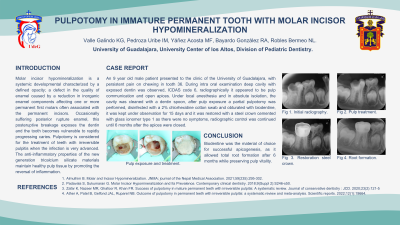Pulp Therapy
352 - Pulpotomy in Immature Permanent Tooth with Molar Incisor Hypomineralization

.jpg)
Karla G. Valle
Resident of Pediatric Dentistry
Universidad de Guadalajara
Unersity of Guadalajara
Tepatitlan, Jalisco, Mexico- RB
Ruben A. Bayardo González, N/A
Universidad de Guadalajara
- NR
Norma L. Robles Bermeo, N/A
Universidad Autónoma del Estado de México.
- MY
María F. Yáñez Acosta, N/A
Universidad de Guadalajara
- IP
Isaac M. Pedroza Uribe, n/a
University of Guadalajara
Zapopan, Jalisco, Mexico - CA
Carmen Celina Alonso Sánchez, University of Guadalajara, Pediatric Dentistry
Program director
Universidad de Guadalajara
Tepatitlan de Morelos, Jalisco, Mexico
Presenting Author(s)
Co-Author(s)
Research Mentor(s)
Program Director(s)
Introduction: Molar incisor hypomineralization is a systemic developmental characterized by a defined opacity; a defect in the quality of enamel caused by a reduction in inorganic enamel components affecting one or more permanent first molars often associated with the permanent incisors. Occasionally suffering posterior rupture enamel, this posteruptive breakage exposes the dentin and the tooth becomes vulnerable to rapidly progressing caries. Pulpotomy is considered for the treatment of teeth with irreversible pulpitis when the infection is very advanced. The anti-inflammatory properties of the new generation tricalcium silicate materials maintain healthy pulp tissue by promoting the reversal of inflammation.
Case report: An 9 year old male patient presented to the clinic of the University of Guadalajara, with persistent pain on chewing in tooth 36. During intra oral examination deep cavity with exposed dentin was observed, ICDAS code 6, radiographically it appeared to be pulp communication and open apices. Under local anesthesia and in absolute isolation, the cavity was cleaned with a dentin spoon, after pulp exposure a partial pulpotomy was performed, disinfected with a 2% chlorhexidine cotton swab and obturated with biodentine, it was kept under observation for 15 days and it was restored with a steel crown cemented with glass ionomer type 1 as there were no symptoms, radiographic control was continued until 6 months after the apices were closed. Biodentine was the material of choice as it allowed the root formation to be successful.
Identify Supporting Agency and Grant Number:

.jpg)